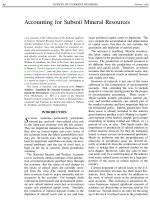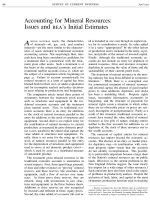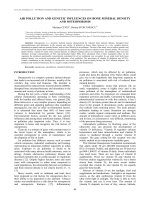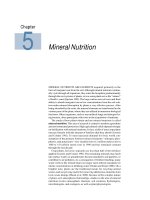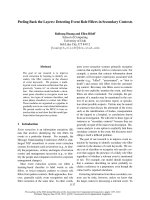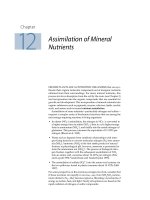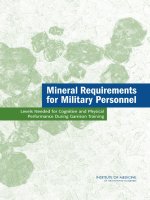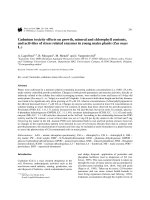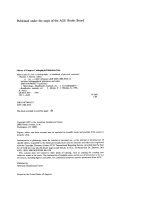Mineral fillers
Bạn đang xem bản rút gọn của tài liệu. Xem và tải ngay bản đầy đủ của tài liệu tại đây (1020.05 KB, 33 trang )
Mineral Fillers
©2009 Dr. B. C. Paul
Credit is given to the following sources, SME Industrial Minerals, Mindat.org,
USGS Minerals Information, Geology.com, mii.org, Webmineral.com,
Geology.com
What and Why of Mineral Fillers
• Mineral filler is ground up rock added to a
mix
– The mineral filler is an additive and modifier,
not the main product.
• Mineral fillers enhance and alter the
product
• Mineral fillers help control product costs by
displacing more expensive ingredients and
taking up space in a product matrix.
Factors Typically Considered in
Filler Selection
•
•
•
•
•
•
Cost
Hardness
Particle Size and Shape
Color
Refractive index properties
Chemical properties
The Paper Market
•
Paper uses fibers to provide strength, but the smoothness, and
reflective properties come from filler.
– Kaolin dominates and provides the brightness to the surface
• Need nice white grades of clay
• Needs to thin down nice so you can get smooth thin coatings (rheology)
– Calcium Carbonate is gaining ground
• Not making paper with acid chemistry as much so calcium carbonate
reactivity not a problem
• Can get from natural grind
• Or precipitation from solution
– Talc
• Helps prevent clumping of wood fibers
– Amorphous silicates
• Adsorb and prevent ink strike through
– Alumina Tri-hydrate
• Releases a lot of water at low temperature and makes paper more fire
retardent.
Talc
Mg 3Si 4O 10(OH)2
Hardness 1 (softest mineral)
S.G. 2.58 - 2.83
Color Colourless, white, pale green
, bright emrald-green to dark green
, brown, gray
Greasy feel
Paint and Ceramics
• Many filler characteristics similar to paper
– Titanium Dioxide provides great whiteness but
it is more expensive
– Pyrophyllite also used
• Pyrophyllite is an important ceramic filler
– Talc also used
– Wollastonite plays similar roles
• It provides permanent expansion on heating (great
if something else is shrinking)
– Of course cheapies like calcium carbonate
and lesser talc are also valuable
UV Absorbance
• Titanium Dioxide minerals add UV
resistance to plastics
• Also used in Sun Screen for same reason
– Zinc oxide competes in this application
Rutile
TiO2
Hardness 6 - 6½
S.G. 4.23
Color Blood red, bluish, brownish yellow,
brown-red, yellow, grayish-black, black,
brown, or violet
(Rutile means red)
Anatase
TiO2
One of the three common
Forms of titanium dioxide
S.G. 3.79 - 3.97
Hardness 5½ - 6
Color Brown, yellowish or reddish brown, indigo blue,
black; greenish, pale lilac, grey, rarely almost
colorless
Brookite
TiO2
One of 3 common forms of
Titanium dioxide
S.G. 4.08 - 4.18
Hardness 5½ - 6
Color Brown, yellowish brown,
reddish brown; dar brown to
iron-black; yellowish brown to
dark brown in transmitted light
Pyrophyllite
Al 2Si 4O 10(OH) 2
Same thing as Talc with Al instead of Mg
Hardness 1 - 2
S.G. 2.65 - 2.9
Color White, gray, pale blue, pale green,
pale yellow, brownish green
Wollastonite
Ca[SiO3]
Hardness 4½ - 5
S.G. 2.86 - 3.09
Color White, gray-white, light green,
pinkish, brown, red, yellow
Wallboard
• White filler powder packed in drywall is usually
gypsum
– Can be mined but synthetic gypsum is also produced
by using limestone to scrub sulfur emissions out of
coal flue gas
• Scrubber gypsum is cheaper than mining gypsum
• Problem is that location and shipping cost to wallboard plants
can negate the cost difference
– Building whole new wallboard plants but that’s a lot of at risk
capital
– The dark side of scrubber gypsum
• Small amounts of ash can give slight gray tone (acceptance)
• Need to control salt content or it will corrode drywall screws
• Countries with a lot of Pyrophyllite fill wallboard
with Pryrophyllite
Gypsum
Ca[SO 4] · 2H 2O
S.G. 2.312 - 2.322
Hardness 2
Color Colorless to white,
often tinged other hues due to
impurities; colorless in transmitted light.
Plastics and Polymers
• Ground Powdered calcium carbonate the dominant
material
–
–
–
–
Provides bright coloring
Low absorbance of oil (an expensive glue in plastics)
Provides high gloss
Hardens against gouging and scaring
• Ground Talc
– Soft but gives very smooth surfaces
– Makes easier to get out of molds – kind of lubricant like
• Calcined clay
– Absorbs in plasticizers very well
• Small amounts of mica, silicates and even barites
Adhesives and Sealants
• Calcium Carbonate and Kaolin
– They are cheap and fill a lot of space without
messing up flow characteristics.
• Drilling mud uses barite for density control
• Kaolin and diatomite prevent caking of
ANFO
• Coal mine rock dust is limestone
Talc and Pyrophyllite Uses
Wollastinite Uses
Relative Cost of Mineral Fillers
Production
Reserves of both are large
Enough to be a non-issue
Density Modifiers
• Lightweight Applications
– Use rocks that start at normal density but have a
tendency to Pop or expand (a lot) when heated
– Perlite
•
•
•
•
Good insulator with low thermal conductivty
Sound adsorbing
Relatively chemically inert
Fire retardant
– Perlite is used
•
•
•
•
•
In lightweight and lightweight precast concrete
Acoustic ceiling tiles
Loosefill insulation
As a soil conditioner
(from regulatory standpoint do need to check for silica
content)
More Lightweight Applications
• Mica alters and stores lots of water
• Rapid water expansion pops the mica like worms
• Vermiculite has more chemically active surfaces
than perlite
–
–
–
–
Is used as a carrier in insecticide sprays
Soaking up and containing oil
Used as a soil conditioner
Also found in lightweight gypsum plasters
• Fire resistant plaster boards
– Can be used as a loose insulator
Barite and the Heavies
• Barite is used in drilling mud
– Its heavy, non-abrasive, and inert
• It is used in heavy concretes
– Concretes needing to weight down pipes in marshy
areas
– Good neutron adsorber so barite based concrete can
reduce lead shielding at nuclear facilities
• Ground form is a filler and extender
– Oil based paints because it does not adsorb oil
– Can be used as a tire filler to add weight
Perlite
Perlite is a water bearing natural glass
That contains Silica, Alumina, Iron, Titanium,
Calcium, Magnesium, Sodium and potasium
Oxides
Vermiculite
(Mg,Fe,Al) 3(Al,Si) 4O 10(OH) 2·4H 2O
Hardness 1½ - 2
S.G. 2.3 - 2.7
Color Brown, bronze-yellow

